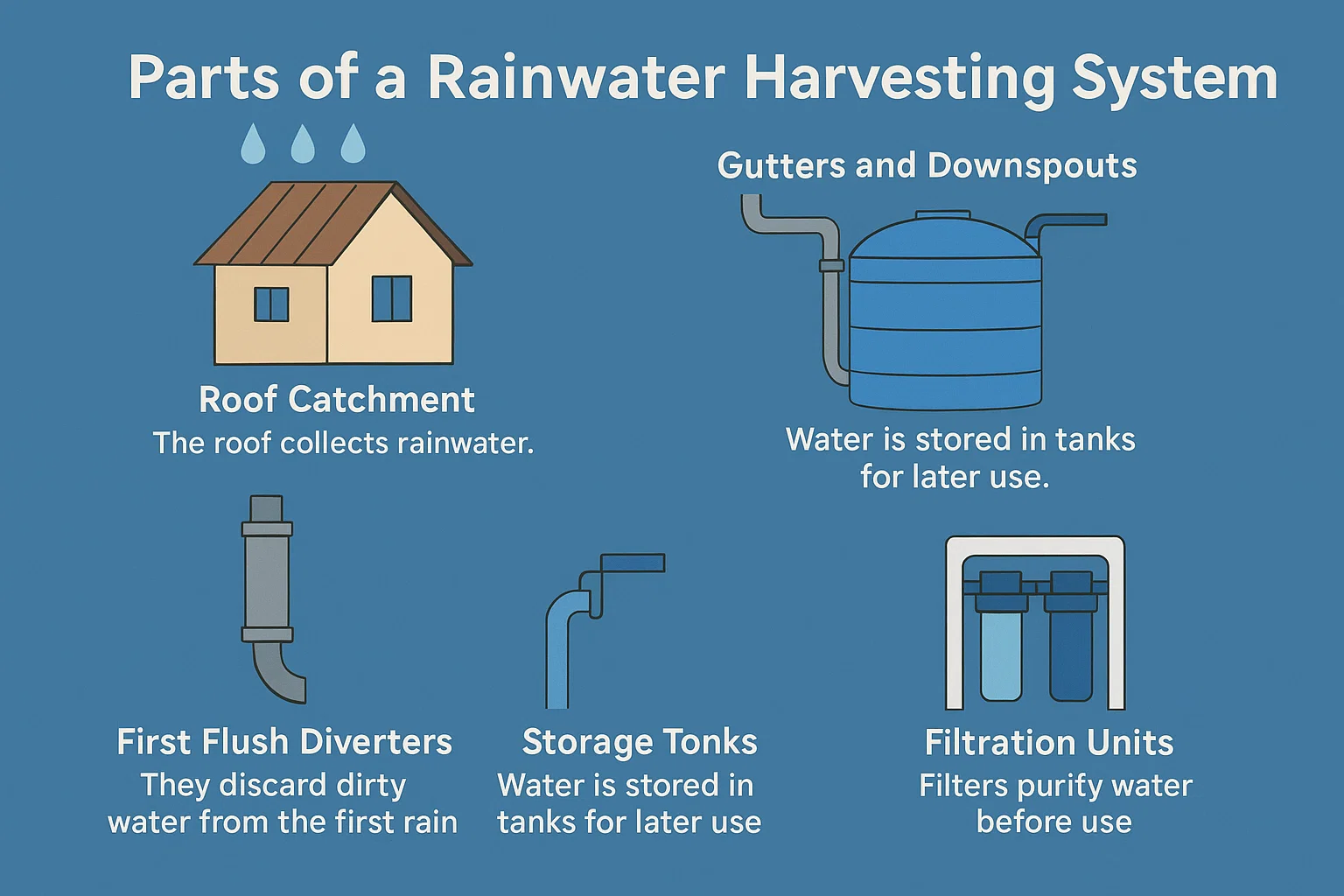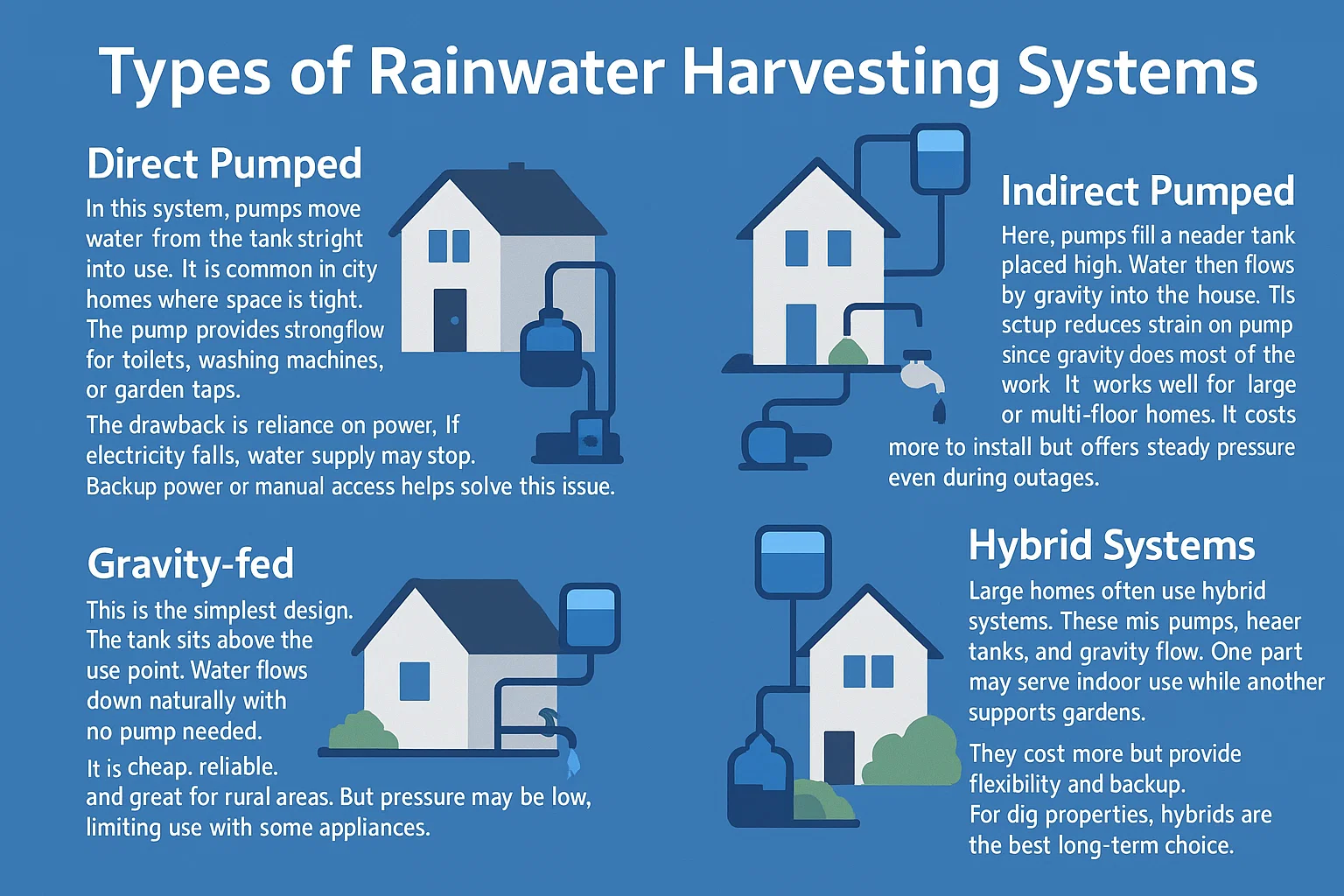Engineering, Construction
The Best Rainwater Harvest Systems in Homes
Rainwater harvesting means collecting and storing rain for later use. Roofs act as catchment areas. Gutters move water into storage tanks. That water can serve many needs, like watering plants, cleaning, and flushing toilets. With treatment, it can even become safe for drinking.
The setup can be simple or complex. Some homes only use a barrel at the gutter end. Others install full systems with pumps, sensors, and filters. Either way, the goal is to save and use rainwater instead of losing it to drains.
Rainwater harvesting is like nature’s recycling plan. It takes a free resource that often goes to waste and makes it useful. In today’s world, where water shortages are growing, it is more than smart. It is necessary.
Why Rainwater Harvesting in Modern Homes is Important
Homes use a lot of water for daily tasks. Many of these tasks do not need treated water. Washing cars, cleaning, or watering plants are perfect uses for rainwater. This helps cut household bills and eases pressure on city systems.
Rainwater harvesting also brings security. Droughts and dry spells are more common now. A home system provides backup water during shortages. Families with tanks worry less about cuts in supply.
Governments and experts promote rainwater harvesting as part of green living. By installing systems, households not only save money but also help the planet. It is a way to live more responsibly and with less waste.
The Importance of Rainwater Harvesting
Environmental Benefits
Harvesting rainwater helps protect the environment. It reduces stormwater runoff that carries dirt and chemicals into rivers. Less runoff means less flooding and cleaner streams.
It also helps recharge groundwater. In cities, concrete blocks natural seepage into soil. Redirecting rainwater into recharge pits restores this process. Over time, this supports aquifers and reduces dependence on wells.
Another benefit is lower energy use. Treating and pumping municipal water takes a lot of power. By using rainwater, households cut the demand on these energy-heavy systems. That reduces carbon output and helps fight climate change.
Economic Savings
Rainwater harvesting saves money. Water bills can drop by 30 to 50 percent. Families that garden or wash cars often see the biggest savings.
These savings add up over time. The system pays for itself within years. After that, water is almost free. For large homes or farms, the financial gain is even higher.
Rainwater systems also protect families from rising water prices. When cities raise tariffs, those with home tanks feel less impact. Their water source is already in place and ready to use.
Less Dependence on Municipal Water
City systems are under strain. Populations grow but water supplies shrink. A rainwater system makes homes less dependent on public networks.
In drought-prone areas, this independence is vital. Families with tanks keep a steady supply, even when neighbors face shortages. On a larger scale, if many homes collect rain, the city itself benefits. It reduces demand, spreads supply, and makes shortages less likely.
Rainwater harvesting turns users into contributors. Each home helps lighten the load on shared systems. Together, these small efforts create a big impact.
Parts of a Rainwater Harvesting System

Roof Catchment
The roof is the first point of contact. Its size, shape, and material decide how much water is collected. Metal and tile roofs are the best. They allow water to flow quickly and stay clean.
Roofs with rough surfaces trap dirt. Some materials may leach chemicals. These are not ideal, especially if the water will be used indoors. Roof washers or leaf guards help keep the system clean.
A well-kept roof is the first step toward safe water. It protects both storage and the people using it.
Gutters and Downspouts
Gutters carry water from the roof. Downspouts guide it into the tank. If gutters are too small, they overflow. If too wide, they collect more debris.
Mesh covers and leaf guards are common solutions. They keep twigs and leaves out while letting water through. Downspouts should be placed well to prevent soil erosion and flooding.
The material matters too. Using rust-free pipes ensures long life. A strong gutter and downspout setup makes the whole system more reliable.
First Flush Diverters
The first rain often washes dirt from the roof. First flush diverters stop this dirty water from entering the tank. They redirect it away until the roof is clean.
This simple device greatly improves water quality. It protects tanks from contamination and reduces the need for heavy filtration later. For families planning to use rainwater indoors, a diverter is essential.
Storage Tanks
The tank is where water is stored. Tanks come in many sizes and materials. Plastic is affordable and light. Concrete is strong and long-lasting. Steel adds strength with style.
Placement is also key. Above-ground tanks are cheaper and easy to maintain. Underground tanks save space and look better but cost more.
Good tanks include overflow outlets, mosquito-proof lids, and drains for cleaning. With the right setup, tanks can last for decades.
Filtration Units
Filters clean water before it reaches use points. Basic systems remove leaves and sand. Advanced ones include UV treatment and charcoal layers. For drinking water, multiple stages are often needed.
The choice depends on use. Garden water needs little filtering. Drinking water requires strict treatment. Filters must be checked and cleaned often to stay effective.
Good filtration keeps water safe, extends tank life, and protects household health.
Types of Rainwater Harvesting Systems

Direct Pumped
In this system, pumps move water from the tank straight into use. It is common in city homes where space is tight. The pump provides strong flow for toilets, washing machines, or garden taps.
The drawback is reliance on power. If electricity fails, water supply may stop. Backup power or manual access helps solve this issue.
Indirect Pumped
Here, pumps fill a header tank placed high. Water then flows by gravity into the house. This setup reduces strain on pumps since gravity does most of the work.
It works well for large or multi-floor homes. It costs more to install but offers steady pressure even during outages.
Gravity-fed
This is the simplest design. The tank sits above the use point. Water flows down naturally with no pump needed.
It is cheap, reliable, and great for rural areas. But pressure may be low, limiting use with some appliances.
Hybrid Systems
Large homes often use hybrid systems. These mix pumps, header tanks, and gravity flow. One part may serve indoor use while another supports gardens.
They cost more but provide flexibility and backup. For big properties, hybrids are the best long-term choice.
Designing a Rainwater System
Factors to Consider
Before building, consider rainfall, roof size, family needs, and space for tanks. In polluted areas, stronger filters are needed. In dry regions, bigger tanks are required.
Legal rules also matter. Some places require permits or certain designs. A clear plan ensures the system works well and meets all standards.
Calculating Storage Needs
Storage depends on rainfall and family use. A formula uses roof size, rainfall, and runoff rate. This gives an estimate of how much water can be collected.
Oversized tanks waste money. Small tanks waste water during heavy rains. A balanced choice saves cost and makes use of all available rain.
Choosing Tank Size and Material
For a family of four, 5,000 to 10,000 liters is common. Bigger homes or dry zones need larger tanks.
Plastic is light and cheap. Concrete lasts longer. Steel is strong but costs more. The choice depends on budget, needs, and design.
Placement and Looks
Tank location affects both use and appearance. Above-ground tanks are cheaper but may look bulky. Underground tanks save space and look better but are costly.
Many people hide tanks with landscaping or coverings. Placement should also allow easy cleaning and safe access. A good balance of function and style makes the system practical and neat.
Installation of Rainwater Harvesting Systems
Step-by-Step Guide
Installing a rainwater system follows a clear process. First, check the roof for safety and cleanliness. Next, fit gutters to guide water toward downspouts. Connect downspouts to a storage tank. Add a first flush diverter to send away the dirty first rain.
Place the tank in a safe spot. Connect inlet and outlet pipes. Add an overflow pipe and a drain for cleaning. Fit filters to keep water clear. For indoor use, install stronger treatment like UV filters.
In advanced setups, pumps are added for steady flow. Sensors may track water levels and send alerts. After setup, test the system for leaks, pressure, and flow.
Simple systems can be installed in a day. Larger systems may take weeks. Careful planning ensures the system works well for many years.
Professional vs DIY Setup
Some people choose to install their own system. A rain barrel or small tank can be done as a DIY project. It saves money but requires basic plumbing skills.
Professional installers handle larger systems. They check roof size, design custom setups, and follow safety rules. They also ensure the system meets local building codes.
DIY is cheaper, but professional work is safer and lasts longer. For complex systems, expert help is the best choice.
Safety Concerns
Safety is key during and after setup. Tanks must be stable and secure. Poor placement may cause collapse or leaks.
Water safety is another concern. Tanks without lids may breed mosquitoes. Stagnant water may grow algae or bacteria. Using covers, screens, and filters reduces risks.
Pumps and wires must be waterproofed. Bad wiring may cause shocks or damage. Following safety steps protects both people and property.
Cost of Rainwater Systems
Initial Setup Costs
Costs vary by design and size. A simple barrel may cost under $200. A full system with pumps, filters, and large tanks may cost $10,000 or more.
The main cost factors are roof size, tank material, filter type, and labor. City homes often pay more for design and appearance. Rural homes often save on labor.
While costs may look high, they are a long-term investment. The system pays for itself in savings.
Maintenance Costs
Running costs are low compared to setup. Cleaning gutters and checking diverters is cheap. Filters may need washing or replacing.
On average, families spend $100 to $300 a year on upkeep. Large systems with advanced filters may cost more.
Good care prevents big repair bills and extends system life. Skipping maintenance often leads to dirty water and expensive fixes.
Long-Term Savings
The savings are real. Bills drop as much as half. Families with gardens or high water use save most.
Over 10 to 15 years, savings often cover the full setup cost. After that, water is nearly free.
Homes with rainwater systems often rise in value. Buyers see them as modern and eco-friendly. This adds another layer of benefit beyond cost savings.
Maintenance and Care
Cleaning Gutters and Tanks
Clean gutters at least twice a year. Leaves, dirt, and bird droppings block flow. Mesh covers reduce work but still need checks.
Tanks also need cleaning. Over time, sediment builds at the bottom. This may cause bad smells or unsafe water. Tanks should be cleaned every two to three years.
Covers and screens keep pests out. Regular cleaning ensures safe, fresh water.
Checking Filters
Filters are key for safe use. Clogged filters slow flow and reduce quality. Some filters only need rinsing. Others need full replacement.
Inspect filters every few months. For drinking water, check more often. Clean filters protect health and keep water clear.
Seasonal Care
Before rainy season, clean gutters and tanks. Test diverters and filters. During heavy rains, check for overflow or leaks.
In dry seasons, inspect tanks for cracks. Sunlight may weaken plastic. Paint or shade covers can help protect them.
Seasonal care keeps the system reliable year-round.
Uses of Harvested Rainwater
Indoor Uses
Rainwater is perfect for indoor needs that do not require drinking water. Flushing toilets, washing clothes, and cleaning floors use a lot of water. Switching these tasks to rainwater saves money.
Rainwater is soft, so it works well in washing machines. It reduces soap use and helps clothes last longer. With proper treatment, it can even be used in the kitchen.
Outdoor Uses
Gardens and lawns love rainwater. It has no chlorine and is gentle on plants. Irrigation is one of the best uses for stored rainwater.
Other uses include washing cars, cleaning patios, or filling pools. Outdoor needs require less filtering, making them the cheapest way to use rainwater.
For Drinking
With strong treatment, rainwater becomes safe for drinking. UV sterilizers, reverse osmosis, or charcoal filters remove harmful microbes and chemicals.
This is vital in rural or dry areas where tap water is scarce. Treated rainwater provides a safe and steady source. While costs are higher, the benefit of safe drinking water is worth it.
Challenges in Rainwater Harvesting
Common Problems
Rainwater systems face issues like leaks, clogged gutters, and dirty tanks. If not cleaned, leaves block flow. Tanks without covers attract insects and animals.
Another problem is water quality. Untreated water may carry bacteria or chemicals. Families who drink untreated water risk illness.
In cities, space is also a problem. Small homes cannot always fit large tanks. Limited budgets also stop some families from building full systems.
Solutions and Fixes
Most problems have simple fixes. Regular cleaning prevents blockages. Covers and screens stop pests.
For water safety, filters and UV systems remove bacteria. Even boiling collected water makes it safe. For small homes, compact tanks or shared systems work well.
Cost is a barrier, but rebates and DIY options lower expenses. Over time, the savings cover the setup cost. With the right approach, challenges do not block success.
Smart Tech in Rainwater Systems
Smart Sensors and Monitoring
Modern systems use sensors to track water levels. Some send alerts when tanks are full or low. Others connect to mobile apps.
This helps families use water more wisely. They can plan use based on storage.
Automation
Smart pumps and valves adjust flow on their own. Some systems switch between rainwater and city water automatically.
This makes systems easier to use and reduces human error. Families save time and avoid shortages.
AI and Future Tools
Artificial intelligence is entering rainwater harvesting. AI can predict rainfall and control tanks. It ensures no water is wasted.
These tools make systems smarter, greener, and more reliable.
Future of Rainwater Harvesting
Trends
Demand for rainwater systems is growing. Climate change is making rain less predictable. Families see the need for backup water.
Green building codes are pushing for eco-friendly systems. Soon, rainwater harvesting will be part of most new homes.
Eco Living
Rainwater harvesting fits with solar power, composting, and other green habits. It supports self-reliance and cuts waste.
Homes that collect rainwater reduce their footprint. They use fewer public resources and live closer to nature.
Innovation
Future systems will be smaller, smarter, and cheaper. New materials will last longer. Smart tools will make them easy to run.
The next generation of rainwater systems will serve not just homes but whole cities.
Conclusion
Rainwater harvesting is a simple, smart, and lasting solution. It saves money, cuts waste, and protects the planet. Families gain water security while helping their communities.
Now is the time to act. Every home can play a role. Start small with a barrel or plan a full system. Clean water is too precious to waste.
If you are ready to take the next step, Nyolenju will help. Reach out today to learn how rainwater harvesting can work for your home. Together, we can make clean water part of every household’s future.
FAQs
1. Can rainwater be used for drinking?
Yes, but it must be filtered and treated first.
2. How much water can I save?
Many families cut water bills by 30 to 50 percent.
3. What size tank do I need?
It depends on your roof, rainfall, and family size.
4. Is rainwater safe for gardens?
Yes, it is free from chlorine and better for plants.
5. How often should tanks be cleaned?
Every two to three years, or sooner if dirt builds up.


